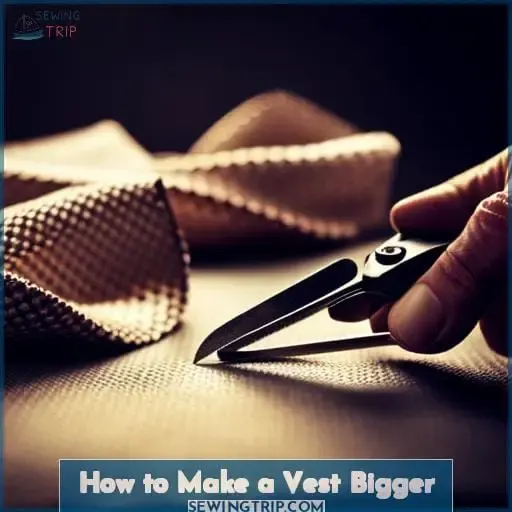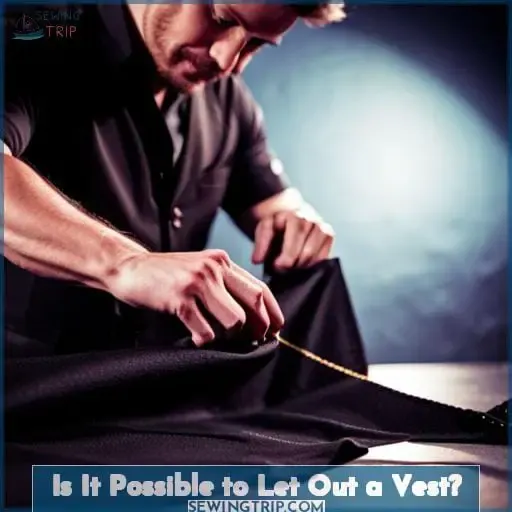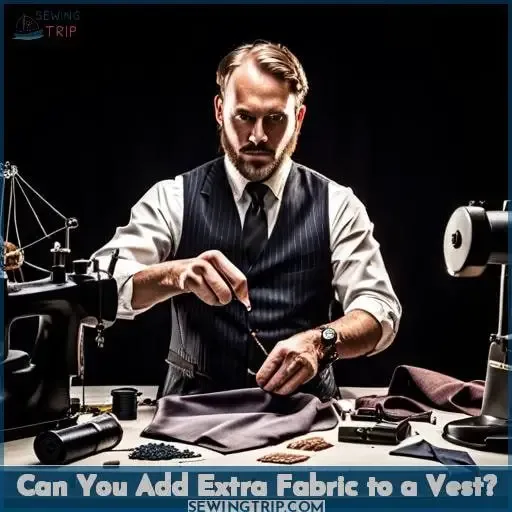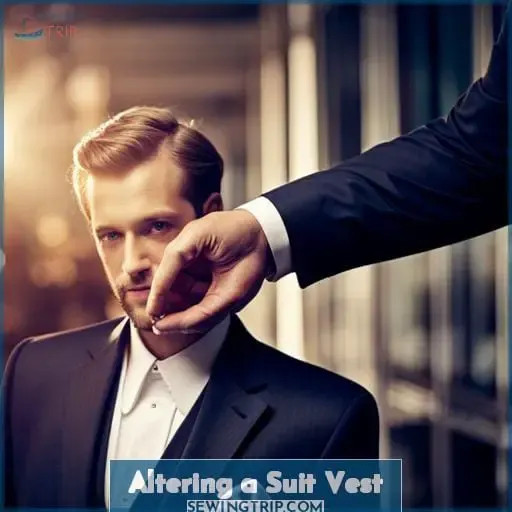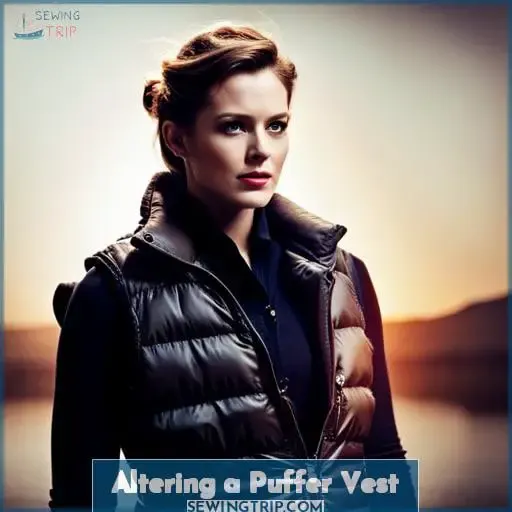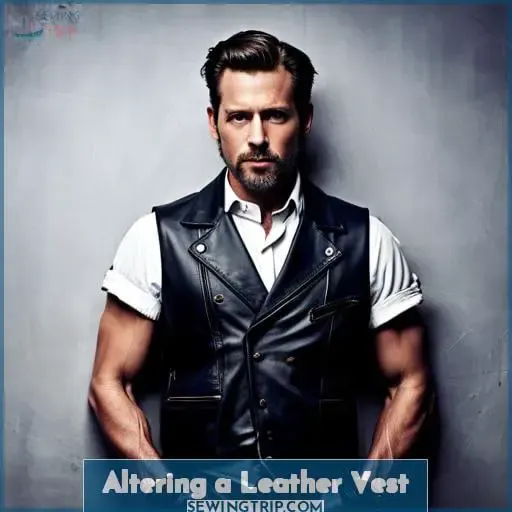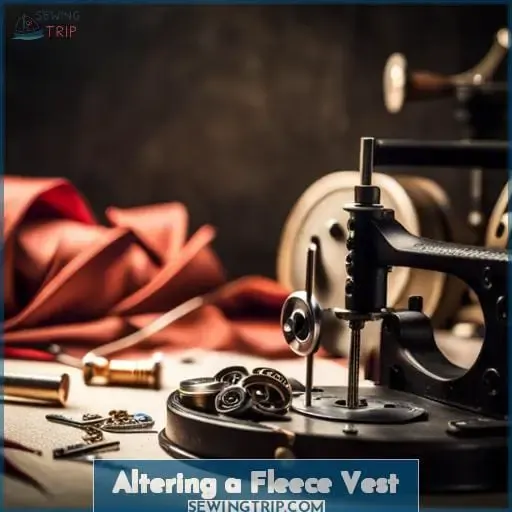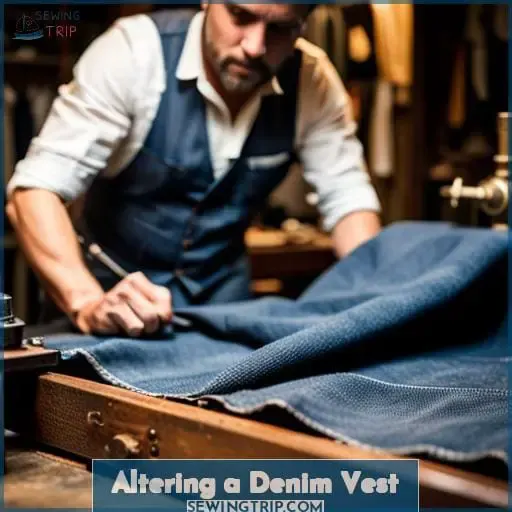This site is supported by our readers. We may earn a commission, at no cost to you, if you purchase through links.
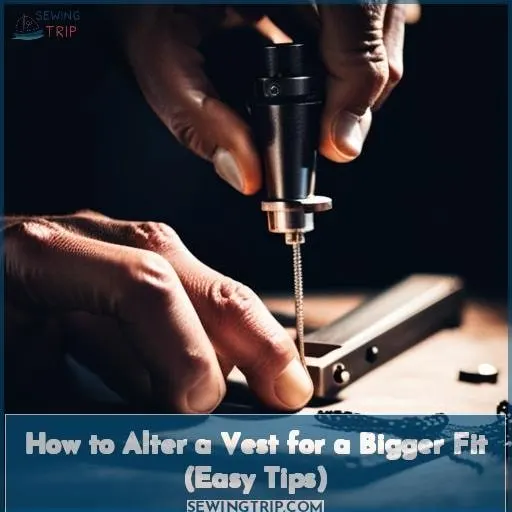 Are you looking to make a vest fit better? Alterations are always tricky, but it is possible with the right technique. If you’re wondering how to make a vest bigger or just want some tips on altering vests in general, then this guide has all the answers.
Are you looking to make a vest fit better? Alterations are always tricky, but it is possible with the right technique. If you’re wondering how to make a vest bigger or just want some tips on altering vests in general, then this guide has all the answers.
Whether you need to let out side seams of adjust darts on your suit or puffer vests, add extra fabric for leather and fleece pieces – even denim – we will cover everything from basics through advanced techniques that can help get your garment fitting perfectly in no time!
So if making alterations is something that’s been giving you headaches lately, take comfort knowing there’s an easy solution right here: learn how to alter any type of vest with confidence today!
Table Of Contents
Key Takeaways
- Taking in the sides can help achieve a snugger fit for a vest.
- Adding extra fabric to a vest requires the expertise of a professional tailor.
- Altering a leather vest can be challenging and risky.
- Adjusting the darts or side seams can make a puffer vest bigger or smaller.
Can You Alter a Vest?
You can alter a vest to fit your body better, such as by taking in the sides or adjusting straps and chains for a snugger fit. Tailoring basics include understanding how to make length adjustments, armhole adjustments, shoulder alterations, and fabric choices that will work best with the design of a vest.
When altering the length of a vest, you must be sure not to shorten it too much; more than an inch can ruin its proportionality.
Waistcoat alterations are slightly different from those on vests, mainly due to their seams being located at the shoulders instead of along side panels like other garments. It is important when making these changes that you keep in mind how they may affect overall proportions since waistcoats typically have shorter lengths compared with jackets or blazers.
The adjustment process should take into consideration all aspects, including armhole size, neckline depth, and widths, etc., before choosing what type of material would work best depending on personal preference between comfortability or style choice.
Even after considering all tailoring basics, one still has difficulty achieving perfection without consulting expert help from professional tailors who understand these nuances well enough.
How to Make a Vest Bigger

Making your vest fit like a glove requires some skill and creativity – it’s like putting together the pieces of a puzzle.
- Adjustments – Taking in sides or adjusting straps/chains can help give vests a snugger fit. Be careful when shortening length as more than an inch may ruin its proportions.
- Fabric Selection – Choose materials wisely for comfortability and style choice, considering armholes size, neckline depth, and widths etc.
- Cost Considerations – Professional tailors understand these nuances well enough; custom makers may offer additional services at higher costs if desired by the customer, but they also come with extra risks involved in making bigger changes such as lengthening the waistcoat or letting out side seams which is unlikely to be successful without replacement parts from the original maker or going through the process of getting a made-to-measure garment done up specially by the tailor themselves!
- Sewing Machine & Experience – A good sewing machine, along with knowledge on how to use it, is key for any alteration work required on vests, including hemming the bottom edge of the garment (if necessary) plus taking care when stitching an adjustable strap around the back area so it’s not too tight nor loose either way!
- Custom Makers – Some custom makers offer double-breasted vests with pleats on the back, while others specialize in partial seam back panels which can still be altered. Though this will require consultation with a professional tailor prior to proceeding further due to the cost considerations mentioned above, as well as other complications arising during the process (e.
In summary, altering a vest successfully requires understanding all relevant aspects beforehand along with having the right tools and experience needed in order to achieve the desired results within the budget constraints set forth by the client themselves, who ultimately decides what fits their individual body shape best overall!
Is It Possible to Let Out a Vest?
Yes, it’s possible to let out a vest with skilled tailoring for a better fit, though this may be challenging due to limited fabric and complications when altering shoulders or armholes.
Different materials require different techniques for alterations. Leather vests are especially tricky as they don’t provide much fabric, and adjusting the shoulder or armhole areas can prove difficult.
On the other hand, waistcoats can have their sides taken in quite easily by drawing new seam lines and sewing along them.
However, letting out the sides of a tailored lined men’s waistcoat requires taking in back seams, which could also mean replacing entire panels depending on how much room measurements need adjustment.
The cost of tailoring varies based on the extent of alterations. Simpler tasks like taking in side seams tend to be cheaper than shortening the length or letting out the sides altogether.
As such, getting an excellent fit from a well-tailored garment is one’s best bet, regardless of whether it’s made from fleece material or denim jeans material.
| Factors | Considerations |
|---|---|
| Adjustments | Taking in sides/adjusting straps/chains, Shortening length (max 1 inch) |
| Fabric Selection | Comfortability & style choice, Armhole size & neckline depth, Width, etc. |
| Cost Considerations (Professional) | Tailors, Custom Makers, Sewing Machine & Experience |
Easy adjustments: take in sides (cost around $30)
Custom Makers
Can You Add Extra Fabric to a Vest?
Adding extra fabric to a vest is not an easy task and usually requires the help of a professional tailor. There are several methods they can use depending on your needs. Adding darts can help create more room in the waist or chest area without making drastic changes to the fit of your garment.
Adjusting straps or chains at the back may also be used for better fitting, as well as replacing entire panels if necessary.
Custom-made vests offer another option that allows you to specify certain details like length and armhole size before purchase.
When adding extra material, make sure there’s enough seam allowance left since too much work could ruin its look entirely – especially when dealing with delicate fabrics like leathers or silks, which don’t provide much room anyway! Also, consider whether it would affect proportions; shortening the length by more than an inch might cause balance issues while lengthening it would require extensive alterations such as creating new panel pieces from scratch!
A few other factors must also come into play when deciding how much alteration needs doing: comfortability & style choice (fitted vs loose), width/length measurements, etc.
Here are some quick tips worth considering:
- Ensure a good fit before purchasing any type of vest; consult a professional tailor if needed.
- Taking in sides is simpler and cheaper compared with adjusting lengths.
- Avoid letting out sides unless absolutely necessary.
- Cost varies based on the extent of alterations/presence of lining.
- Consider comfortability & style choice when selecting fabric.
Altering a Suit Vest
Altering a suit vest requires great skill and attention to detail, so it’s important to consult an experienced tailor if you want a perfect fit.
Fabric Adjustments:
- Taking in sides
- Adjusting Straps/Chains
- Letting out Sides
Seam Adjustments:
- Shoulder Alterations
- Letting out Sides
- Shortening Waistcoat
A tailored fit can make all the difference when wearing a suit vest. It is essential that the waist circumference is accurately measured before any modifications are made, as this will determine how much fabric needs adjusting or adding.
Taking in side seams is one of the simplest methods for making vests smaller. Shoulder alterations can be more challenging due to tight armholes and lack of extra material. Letting out sides may not always yield satisfactory results as most suits don’t have enough fabric allowance for such adjustments.
However, adjusting straps or chains at the back can help provide a better fit without altering too much material.
Additionally, lowering necklines on vests with partial back seam construction allows for further customization when needed.
For those looking to shorten their waistcoats, seek professional advice first since it could negatively affect proportions if not done correctly.
Finally, double-breasted designs with pleats on the back offer unique tailoring possibilities.
Altering a Puffer Vest
Altering a puffer vest is not for the faint of heart, but it can be done with some basic knowledge and attention to detail. Taking in or letting out side seams, as well as adjusting darts, are two key steps when making a puffer vest bigger.
Taking in or Letting Out Side Seams
You can tailor your puffer vest to perfection by taking in or letting out the side seams.
For a well-fitted look, measure your waist circumference and compare it with the measurements of the vest before making any adjustments.
Heavy work is usually required for adjusting fit. Fabric pins are used to mark new seam lines, then sewn along them after folding up excess material from each side where needed.
Professional tailors may also adjust darts in unique cuts like v necklines for better drape and balance of fabric on body shape.
A tailored waistcoat will make you stand out from the crowd while still looking natural – provided that proper measures are taken during alterations!
To ensure success, take time documenting exact measurements beforehand and consult an experienced tailor who knows exactly how much room should be there between garment size and individual’s measurement based on style preferences or other factors such as desired comfort level, etc.
This step is essential when creating a perfectly fitted piece!
Adjusting Darts
Darting your puffer vest is like sculpting a masterpiece, allowing you to tailor the perfect fit around every contour of your body. Adjusting waistbands and extending hems gives you control over design elements that can make or break an ill-fitting vest.
To ensure success, first mark the new hemline. Then, fold up the excess material before pinning it in place for sewing along the marked lines. If needed, replacing panels with more fabric may be necessary when sizing shoulders and customizing cuts, such as v-necklines.
However, it’s important to note that the amount of room between the garment size and individual’s measurements depends on style preferences or desired comfort level.
With careful consideration given to these details, you’ll have a perfectly fitted piece ready for any occasion – without spending too much money!
Altering a Leather Vest
Making adjustments to a leather vest can be challenging and risky, but with the right help, you may be able to achieve the perfect fit. It’s important to remember that adding length is difficult due to the lack of extra fabric in most vests, so it’s best left up to an experienced tailor.
Shoulder and armhole adjustments are also tricky as they require precise alterations for proper fitting.
Here are three tips when altering a leather vest:
- Consult with your tailor before attempting any major adjustments – they will know what kind of changes can realistically be made without damaging the material or compromising on quality.
- Ensure there is enough extra fabric around the front panel and back panels of your self-back waistcoat.
- Try on frequently during the alteration process for a perfectly-fitting vest!
For those who want more tailoring advice beyond just making their own vests bigger, some custom makers offer double-breasted vests with pleats in the back or partial seams, which make them easier (and less expensive) to alter than other types of tailored lined men’s waistcoats.
Making shoulders smaller/narrower may prove an even tougher task though – but consulting an experienced tailor should provide insights into how much room needs between measurements and the desired style/cut.
With careful consideration throughout all steps involved in altering a leather vest, you’ll likely end up wearing something truly special!
Altering a Fleece Vest
Altering a fleece vest can be challenging, especially when it comes to adjusting the sides. It’s important to note that complications may arise if there is an inner fabric lining.
Taking in or Letting Out Sides
Altering the sides of a vest can help you achieve a perfect fit—whether it’s taking in or letting out for added room. To adjust straps, try removing extra length from the back panel and securing it with snaps or buttons.
Hem length is important too. If you’re shortening it by more than an inch, seek the assistance of a good tailor to get the best results. Letting out side seams takes serious work. Look into custom makers who offer tailored looks without sacrificing quality and comfort.
For those wanting to take in the sides instead, measure your waist circumference and then subtract that number from the measurement taken on the vest for a perfect fit. Mark new seam lines accordingly before proceeding to sew along the marked seam line(s).
Adjusting shoulder seams can also give you the desired fitted look, but be sure to consult with professional tailors first as this requires precise alterations! With these tips in mind, achieving the ultimate tailored vest isn’t far off.
Complications With Inner Fabric Lining
When it comes to fleece vests, complications can arise when attempting to alter the inner fabric lining. Professional tailors are skilled in adding extra fabric while taking in sides for a snug but not uncomfortable fit around your waist.
While sewing a hem is an easy task, if you’re shortening length more than an inch then seek help from experienced custom makers who have much canvas and understand what works best for your body type. Remember that adjusting just a small part of your waist won’t give optimum results.
Instead, mark newly marked seams which will provide the right size with no messy look! A tailor’s expertise is indispensable here as they know how to make alterations without compromising quality or comfort.
Altering a Denim Vest
You can take in side seams of a denim vest to make it bigger, and typically the cost for such an alteration is around $30 – making it one of the most affordable adjustments. This type of adjustment involves adding fabric to existing side panels, pinning along seams to create new shape and stitching into place.
It may not be as difficult as major surgery on formal looks like Dickens’ style vests with partial back seam or well-known names with full backs, but it still requires careful consideration.
When making adjustments on any garment, even something simple like a denim vest that has no lining or inner fabric layer, there are still some factors you should keep in mind:
- Measure twice before cutting once; this will ensure accuracy when taking in sides which will have an effect on overall fitment after alterations are completed.
- Shortening length is much harder than just taking in sides, so if possible try not to shorten too much at once – more than 1 inch could affect balance and proportions drastically if done incorrectly resulting in unsatisfactory results.
- If altering from shoulder seams, ensure they remain balanced when marking lines for alterations; otherwise, your project could become unevenly weighted leading to potential problems down the line during wearability tests!
- Be sure to adjust straps/chains at the back properly so that fitment remains comfortable without being constricting while also providing good coverage over the waistband area (if desired).
Altering denim vests can seem intimidating, but by keeping these tips handy, you’ll be able to achieve great results tailored specifically towards your needs! With the proper tools (measuring tape & needle) plus patience & skillful expertise, you’ll soon have yourself looking sharp(er) again!
Frequently Asked Questions (FAQs)
Is it possible to make a vest longer?
It is possible to lengthen a vest, although it can be tricky. An experienced tailor might shorten the shoulder seams for balance and proportion, while adding fabric may not yield satisfactory results.
How much does it cost to have a vest tailored?
The cost of tailoring a vest varies depending on the extent of alteration and the presence of lining. A skilled tailor can provide an accurate estimate for any alterations you need, so be sure to consult them before making your purchase.
What is the difference between a vest and a waistcoat?
A vest is typically a sleeveless top worn over shirts or sweaters. In contrast, waistcoats are tailored garments that extend to the waist or hips and usually feature buttons down the front. Both can be altered for a better fit, but altering shoulder seams on vests can be more challenging than adjusting sides on waistcoats.
What type of alterations can be made to a waistcoat?
Step into the future of fashion by altering your waistcoat! Make small adjustments such as taking in the sides, lowering the neckline, or adjusting the darts for a perfect fit.
Are there special techniques for altering different types of vests?
Yes, different techniques are necessary for altering various types of vests. For instance, a tailored lined men’s waistcoat requires taking in the back seam, while leather vests need adjustments to the shoulder and armholes.
Shortening the length is tricky but possible; puffer or fleece vests may have complications due to the lining. Denim vests can be taken in at the side seams, while suit styles usually involve vertical sides only.
Conclusion
Altering a vest can be a challenging task, but with the appropriate tools and a little bit of know-how, you can transform an ill-fitting vest into something that looks and feels as if it were made just for you.
Whether you need to make it larger, smaller, or simply tailor it to fit your body perfectly, you can trust that a skilled and detail-oriented tailor is the only one who can ensure your vest looks amazing.

